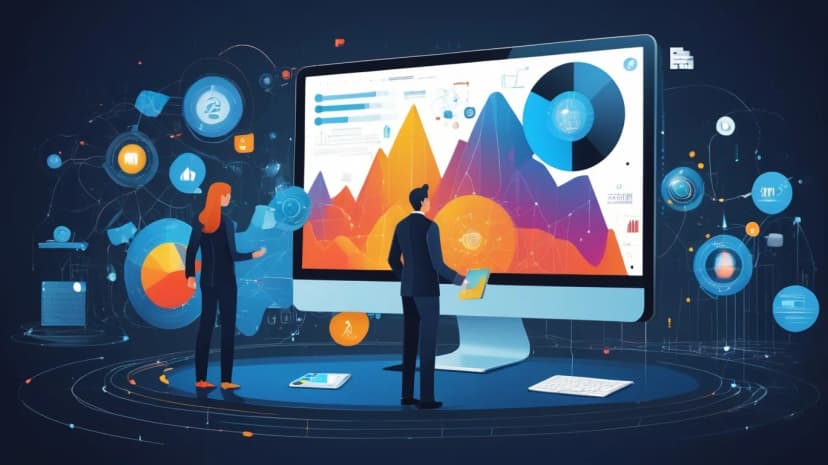The one thing that makes you different from other thought leaders is the unique ideas that you present to your audience. Thought leadership research is a powerful tool that will help you stand out in the crowd. By generating unique content, sharing valuable insights, and discussing industry trends, companies can position themselves as forward-thinking and innovative leaders resulting in enhanced trust and credibility. If you’re starting with creating your resources, then this guide will help you to understand the ins and outs of the research process.
Defining Thought Leadership Research
The thought-leadership research process is creating, analyzing, and sharing in-depth trends or data to inform or influence the audience. Unlike typical content marketing strategy, this leadership research imparts knowledge to users and focuses on solving their problems and both are part of thought leadership strategy. With rigorous data analysis, expert commentary and market insights thought leadership research aims at embarking on discussions, influencing decision making, and setting trends. In a nutshell, thought leadership research is digging beyond the first layer. It pushes the boundaries and invites the audience to collaborate and explore new ways of resolving complex problems.
Difference Between Thought Leadership Research And Content Marketing
Thought leadership research and content marketing are correlated but individually they are far different. We see people often get confused between the two. Therefore, before diving into thought leadership research, we would like to clear out the fog on this topic. Let’s understand:
- Purpose:
- Thought leadership research: Build authority and credibility by sharing data-driven, deep insights
- Content Marketing: Focuses on engaging customers and generating leads through various
- Depth of topics:
- Thought leadership research: Covers niche topics, but in-depth analysis of each.
- Content Marketing: Covers a broader list of topics.
- Audience:
- Thought leadership research: Appeals to decision-makers and influencers in the domain.
- Content Marketing: Potential consumers who will take up the product/service.
Why Thought Leadership Research Is Essential?
Let’s understand why we need thought leadership research:
- Build trust and credibility: when an organization provides valuable resources on any topic, the audience starts to view it as a reliable source of industry information. This helps organizations earn trust and credibility among their audience.
- Educate: by sharing insights on trends, technologies, or methodologies, organizations equate the market and fill in the knowledge gaps. This helps the audience to make informed decisions and navigate through complex problems.
- Influencing trends: Companies doing thought leadership research often set the direction of discussion and trends in the domain. Either by highlighting issues or influencing other strategies, these companies play a role in shaping the future of that particular sector.
- High-Quality leads: Thought leadership content attracts high-quality leads as the content attracts people who are genuinely interested in the product. These individuals generally value expert guidance and build long-term business relations.
- Be different: Thought leadership research helps you develop a different perspective or approach, unlike anyone else. This becomes a crucial differentiating factor between you and your competitors.
What Are The Key Components Of Thought Leadership Research?
Conducting thought leadership research that resonates with the audience requires careful planning and execution. These are the key components you must include while doing your research:
- Identifying good topics: Identifying relevant and valuable topics is important for your thought leadership research. You must understand your audience’s pain point and what will benefit them the most.
- Conduct original research: to produce valuable content, companies perform original research in the form of surveys, interviews, case studies, or experiments. If these resources are not available to you, you can also outsource them.
- Data interpretation: Collecting data is one thing but interpreting it into effective and useful information is an entirely new chapter. Data analysis is done to uncover any patterns, trends, correlations, or findings. These finding needs to be presented in a way that is informational at the same time easy to understand.
- Providing actionable insights: The audience benefits the most from thought leaders who not only share insights but also give actionable tips to resolve issues. The information provided by you in any research must help the audience to apply that knowledge to their business.
- Great presentation: if you have excellent content but zero readability, it will not reach the audience how you want it. Therefore, you must ensure your research paper/resource presentation is of high quality.
- Distribution: conducting research and then building resources takes time and effort. If it doesn't reach the targeted audience then it is an utter waste of all. Therefore, you must ensure the resources reach the audience via pre-defined channels.
Steps To Conduct Research
Conducting research is a rigorous process and takes many steps to be completed. Let’s discuss the elaborated pathway of conducting research for yourself or your brand:
- Define your goals
Firstly, you need to define your goals before starting with the process. You need to identify if the research is to educate the audience, build credibility, or influence industry trends. Defining the goals will help you direct your research. Next up, you need to find out your target audience. This will define your style of writing, language, presentation, and platforms you decide to distribute your resource.
- Choose a relevant topic
You must choose a topic that resonates with your expertise and your audience’s needs. Conducting market analysis or keeping track of industry conversations will help you decide on the topic.
- Mode of research
Now, depending on your topic and goal you need to define the mode of research. It can be:
- Surveys and polls: gather data from a larger audience
- Interviews: conduct interviews with industry experts
- Case studies : analyze real-world applications
- Experiments: test hypothesis to gather new data
- Collect data
Make sure, as per your mode of research you collect your data. The data must be accurate and reliable. Make sure the sample size you select is large enough to yield meaningful results.
- Data interpretations
Carefully analyse the data to convert it into meaningful information. Statistical analysis can add depth to your interpretation but simple correlations are also valuable.
- Create the content
Now, once you have the data with you- you can select the mode of content. It can be videos, blogs, research paper, whitepapers or ebooks based on the content creation requirement. Depending upon your target audience you can make the selection.
- Distribute
Lastly, distribute your resource in the channel wherein your target audience is most active. It can be your website, social media, newsletters, webinars, or industry publications.
Case Studies: Successful Thought Leadership Research
- Deloitte's Global Human Capital Trends Report
This report is the benchmark of thought leadership research. The report encompasses workforce trends, technologies, and practices that impact HR and business strategies globally. Deloitte conducts research by interviewing thousands of business and HR leaders, to generate a report that is enriched with data and insights from the real world. This report is one of the reasons why Deloitte is a prominent thought leader in HR transformation.
- LinkedIn workplace Learning report
This report is another remarkable example of leadership research done right. This report is based on the data from LinkedIn’s vast database, and surveys of L&D professionals globally. It is a comprehensive guide to look up learning and development trends. The report is an excellent resource for HR professionals to make informed decisions about training, skill development, employee engagement, and employee satisfaction. This has successfully positioned LinkedIn as an authority in the learning and development space.
- IBM’s Cost of Data Breach Report
IBM publishes an annual report “Cost of data breach” providing data and insights on cyber security threats, and the financial impact of it. This report is co-partnered by “Ponemon Institute” which is extensively referred by cyber security professionals and decision-makers. The findings help organizations make more informed decisions and avoid cybersecurity breaches. This report reinforces IBM’s reputation as a thought leader in Cyber security and IT sector.
Thought leadership research is a powerful tool when utilised correctly. If you want to establish yourself as a thought leader, we highly recommend putting out resources in the market based on your original research. This will not only help you build a broader audience base but also develop trust among your clientele.





